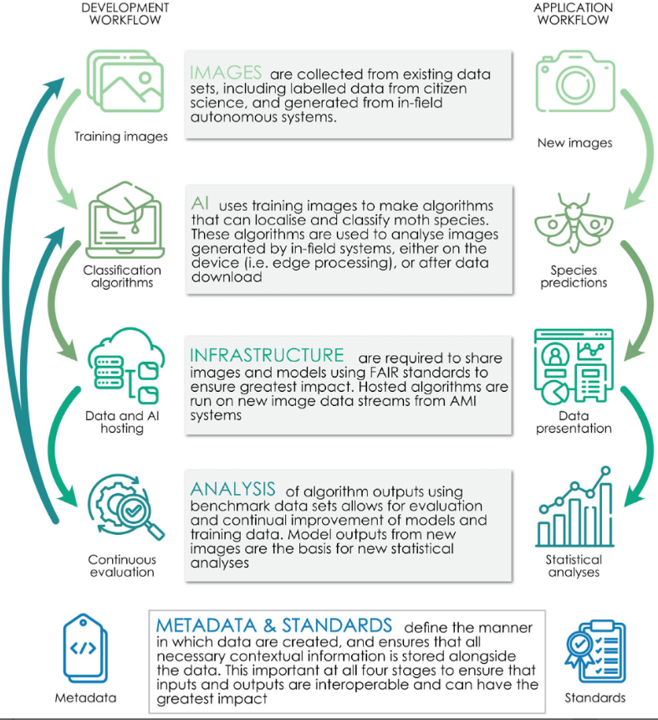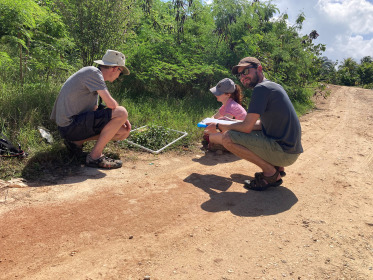Recent publications from scientists at the Biological Records Centre and others from the UK Centre for Ecology and Hydrology have covered a wide range of topics related to biological recording. These include important developments in statistical methodology and the use of technology technological advancements, which will complement the vital work of the national recording schemes and societies, and the wider biological recording community.
Developing statistical methods to analyse biological recording data
Rob Boyd and colleagues have published two papers dealing with issues of bias that are common in citizen science datasets. The first reviews available methods for adjusting descriptive inferences (e.g. indicators) from geographically biased data using an example from UK plant recording, and the second considers uses simulation and analytical insights to consider the trade-off between accuracy and spatial scale when using biased data. This is another key topic for citizen science and lay behind the decision to produce distribution trends at 10 km (rather than finer scales) in the BSBI Plant Atlas 2020 project.
Emma Gardner and colleagues present a family of process-based models that simulate landscape use by multiple taxa. The models were co-developed with researchers, NGOs and Citizen Scientists, whose knowledge helped to design the models’ structure (i.e. choose what processes needed to be included in the models according to what was known through literature, on-the-ground and local knowledge to be important for species) and parameterise the models (through a combination of expert opinion and field study results). The models were then validated against species observations collected by a wider network of volunteer surveyors who support both national and local monitoring programmes in the UK.
Boyd RJ, Stewart BJ, and Pescott OL. (2024). Descriptive Inference Using Large, Unrepresentative Nonprobability Samples: An Introduction for Ecologists. Ecology 105(2): e4214. https://doi.org/10.1002/ecy.4214
Callaghan CT, Santini L, Spake R, Bowler DE. (2024). Population abundance estimates in conservation and biodiversity research. Trends in Ecology & Evolution (not yet assigned to an issue) https://doi.org/10.1016/j.tree.2024.01.012
Gardner, E., Robinson, R.A., Julian, A. et al. A family of process-based models to simulate landscape use by multiple taxa. Landsc Ecol 39, 102 (2024). https://doi.org/10.1007/s10980-024-01866-4
Emerging technologies for biological recording
Cardoso AS, Malta-Pinto E, Tabik S, August T, Roy HE, Correia R, Vicente JR, Vaz AS. (2024). Can citizen science and social media images support the detection of new invasion sites? A deep learning test case with Cortaderia selloana. Ecological Informatics: article 102602 (not yet assigned to an issue, open access) https://doi.org/10.1016/j.ecoinf.2024.102602
Roy DB, Alison J, August TA, Bélisle M, Bjerge K, Bowden JJ, Bunsen MJ, Cunha F, Geissmann Q, Goldmann K, Gomez-Segura A, Jain A, Huijbers C, Larrivée M, Lawson JL, Mann HM, Mazerolle MJ, McFarland KP, Pasi L, Peters S, Pinoy N, Rolnick D, Skinner GL, Strickson OT, Svenning A, Teagle S, Høye TT. (2024). Towards a standardized framework for AI-assisted, image-based monitoring of nocturnal insects. Philosophical Transactions of the Royal Society B: Biological Sciences 379(1904): article 20230108 (open access) https://doi.org/10.1098/rstb.2023.0108

Sheard JK, Adriaens T, Bowler DE, Büermann A, Callaghan CT, Camprasse ECM, Chowdhury S, Engel T, Finch EA, von Gönner J, Hsing P-Y, Mikula P, Rachel Oh RY, Peters B, Phartyal SS, Pocock MJO, Wäldchen J, Bonn A. (2024). Emerging technologies in citizen science and potential for insect monitoring. Philosophical Transactions of the Royal Society B: Biological Sciences 379(1904): article 20230106 (open access) https://doi.org/10.1098/rstb.2023.0106
Entomological research
de Groot MD, Christou M, Pan JY, Adriaens T, Maes D, Martinou AF, Roy HE, Verbeken A, Haelewaters D. (2024). Beetlehangers.org: harmonizing host–parasite records of Harmonia axyridis and Hesperomyces harmoniae. Arthropod-Plant Interactions (not yet assigned to an issue, open access) https://doi.org/10.1007/s11829-023-10037-2
Luke, S.H., Roy, H.E., Thomas, C.D., Tilley, L.A.N., Ward, S., Watt, A. et al. (2023) Grand challenges in entomology: Priorities for action in the coming decades. Insect Conservation and Diversity, 16(2), 173–189. Available from: https://doi.org/10.1111/icad.12637
Svenningsen CS, Peters B, Bowler DE, Dunn RR, Bonn A, Tøttrup AP. (2024). Insect biomass shows a stronger decrease than species richness along urban gradients. Insect Conservation and Diversity 17(2): 182-188 (open access) https://doi.org/10.1111/icad.12694
Diversity and the global reach of biological recording
Nuñez MA, August T, Bacher S, Galil BS, Hulme PE, Ikeda T, McGeoch MA, Ordonez A, Rahlao S, Truong TR, Pauchard A, Roy HE, Sankaran KV, Schwindt E, Seebens H, Sheppard AW, Stoett P, Vandvik V, Meyerson LA. (2024). Including a diverse set of voices to address biological invasions. Trends in Ecology & Evolution (not yet assigned to an issue) https://doi.org/10.1016/j.tree.2024.02.009
Roy HE, Martinou AF, Pocock MJO, Werenkraut V, Roy DB. (2024). The global reach of citizen science for monitoring insects. One Earth 7(4): 552-557 (open access) https://doi.org/10.1016/j.oneear.2024.03.009

